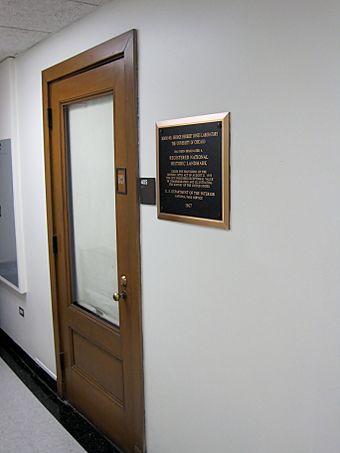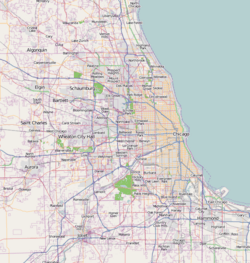George Herbert Jones Laboratory facts for kids
Quick facts for kids |
|
|
Room 405, George Herbert Jones Laboratory
|
|

George Herbert Jones Laboratory
|
|
| Location | 5747 S. Ellis Ave. Chicago, Illinois |
|---|---|
| Built | 1942 |
| NRHP reference No. | 67000005 |
| Added to NRHP | May 28, 1967 |
The George Herbert Jones Laboratory is a building at the University of Chicago in Chicago, Illinois. It's famous because of a special room inside it, Room 405. In 1967, this room was named a National Historic Landmark. This is because it was the place where scientists first isolated and measured plutonium. Plutonium is a very important element, and it was the first one made by humans!
Contents
What is the Jones Laboratory?
The George Herbert Jones Laboratory is a four-story building. It was built in 1928 and 1929. The university used it for its chemists and students to do research and learn about chemistry. It's located on the main campus of the University of Chicago.
Room 405: A Special Place
Room 405 is on the fourth floor. It's a small room, about 6 by 9 feet (1.8 by 2.7 meters). It has shelves and counters along its walls. A simple wooden door with a glass window leads into the room.
The Discovery of Plutonium
During World War II, the U.S. War Department started a secret project called the Manhattan Project. Its goal was to develop nuclear technology. As part of this project, chemists at the University of Chicago began to study a new radioactive element called plutonium.
Room 405 was the exact spot where this amazing discovery happened. On August 18, 1942, a team led by physicist Glenn Seaborg isolated a tiny amount of plutonium for the very first time. Later, on September 10, 1942, they took measurements that helped them figure out the new element's atomic weight.
This was a huge step for science! It made it possible to create both nuclear power (for electricity) and nuclear weapons. Glenn Seaborg later said that these days would be remembered in science history. They marked the first time a synthetic element (an element made by humans) was seen. It was also the first time a measurable amount of an artificially made isotope (a version of an element) was isolated.
Cleaning Up the Lab
In the 1980s, the U.S. Department of Energy worked to clean up the Jones Laboratory. They studied and removed almost all of the radioactive waste from the World War II era. This cleanup happened in 1982, 1983, and 1987.
Today, Room 405 doesn't look exactly like it did back then. However, in the lobby of the laboratory, you can see a collection of the special equipment that was used for those important measurements. Even though the building's basement and ground floor were damaged by an explosion in 1973, Room 405 was not harmed.
Images for kids





